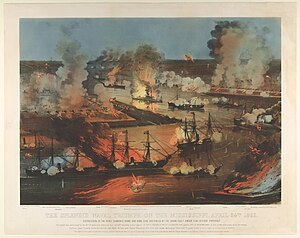| Battle of Forts Jackson and St. Philip | |||||||
|---|---|---|---|---|---|---|---|
| Part of the American Civil War | |||||||
 Attack of the Union fleet, April 24, 1862; Fort Jackson at left and Fort St. Philip is shown at right | |||||||
| |||||||
| Belligerents | |||||||
|
|
| ||||||
| Commanders and leaders | |||||||
| David G. Farragut |
Johnson K. Duncan John K. Mitchell John A. Stephenson | ||||||
| Units involved | |||||||
| West Gulf Blockading Squadron |
Fort Jackson Fort St. Philip River Defense Fleet | ||||||
| Casualties and losses | |||||||
| 229[1] | 782[1] | ||||||
The battle of Forts Jackson and St. Philip (April 18–28, 1862) was the decisive battle for possession of New Orleans in the American Civil War. The two Confederate forts on the Mississippi River south of the city were attacked by a Union Navy fleet. As long as the forts could keep the Federal forces from moving on the city, it was safe, but if they fell or were bypassed, there were no fall-back positions to impede the Union advance.
New Orleans, the largest city in the Confederacy, was already under threat of attack from its north when David Farragut moved his fleet into the river from the south. The Confederate Navy had previously driven off the Union blockade fleet in the Battle of the Head of Passes the previous October. Although the Union threat from upriver was geographically more remote than that from the Gulf of Mexico, a series of losses in Kentucky and Tennessee had forced the Confederate War and Navy Departments in Richmond to strip the region of much of its defenses. Men and equipment had been withdrawn from the local defenses, so that by mid-April almost nothing remained south of the city except the two forts and an assortment of gunboats of questionable worth.[2] Without reducing the pressure from the north, (Union) President Abraham Lincoln set in motion a combined Army-Navy operation to attack from the south. The Union Army offered 18,000 soldiers, led by the political general Benjamin F. Butler. The Navy contributed a large fraction of its West Gulf Blockading Squadron, which was commanded by Flag Officer David G. Farragut. The squadron was augmented by a semi-autonomous flotilla of mortar schooners and their support vessels under Commander David Dixon Porter.[3]

The expedition assembled at Ship Island in the Gulf. Once they were ready, the naval contingent moved its ships into the river, an operation that was completed on April 14. They were then moved into position near the forts, and on April 18 the mortars opened the battle.[4]
The ensuing battle can be divided into two parts: a mostly-ineffective bombardment of the Confederate-held forts by the raft-mounted mortars, and the successful passage of the forts by much of Farragut's fleet on the night of April 24. During the passage, one Federal warship was lost and three others turned back, while the Confederate gunboats were virtually obliterated. The subsequent capture of the city, achieved with no further significant opposition, was a serious, even fatal, blow from which the Confederacy never recovered.[5] The forts remained after the fleet had passed, but the demoralized enlisted men in Fort Jackson mutinied and forced their surrender.[6]

- ^ a b Cite error: The named reference
NPSwas invoked but never defined (see the help page). - ^ Hearn, Capture of New Orleans, 1862, pp. 117, 122, 148. Duffy, Lincoln's admiral, pp. 99–100.
- ^ Duffy, Lincoln's admiral, pp. 62–65. Butler had 18,000 troops at Ship Island, but the number he transported to the Mississippi before the battle was smaller.
- ^ Hearn, Capture of New Orleans, 1862, pp. 180–186,
- ^ Simson, Naval strategies of the Civil War, p. 106. Duffy, Lincoln's admiral, pp. 113–114.
- ^ Duffy, Lincoln's admiral, p. 110. ORN I, v. 19, pp. 131–146. ORA I, v. 6, pp. 525–534.
- ^ ORN I, v. 18, p. 131.